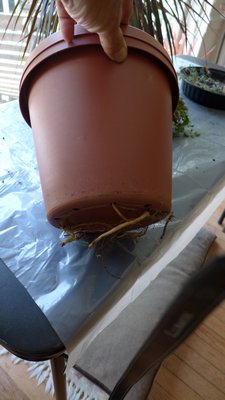

It’s been a pretty incredible spring and summer for us gardeners, with beds and borders lush with flowers, vegetable gardens producing like crazy, and the fruits and berries looking pretty fine as well. It’s certainly keeping us busy—but we need to be careful not to forget our indoor plants, because this the perfect time to give them some TLC and reap the dividends.Tending to your indoor plants, even if they’re outdoors for the summer, means they’ll remain healthy through the cooler and darker months of the year. The regimen for their care now can be summed up in seven words: inspect, re-pot, prune, spray, feed, propagate and buy. The order can be mixed up a bit, but the next couple of weeks is the perfect time to take advantage of the weather and get these plants back into their prime and maybe make a few more for just a few pennies.
Houseplants that are taken outdoors for the summer, or even just a day or a few weeks, can get sunburn and scald just like we do. If you’re moving these plants around, move them from areas of lower light to brighter light gradually—and never move an indoor plant into direct full sun. A plant’s foliage can burn in a short time, and then the damage is done.
And any houseplant that’s going to go back indoors should be regularly inspected for insects, slugs and snails, and at the very least the foliage should be sprayed with room temperature water to clean them off.
Rinsing the foliage not only removes dust and dirt but, when done properly, can wash off one of the worst insect problems: the two-spotted spider mite. These tiny mites thrive indoors, and when it gets hot and dry outdoors, they just love it. The good news is that fine but forceful sprays of water will wash them off the foliage, and repeating this process several times a week washes off successive generations that emerge from the eggs left behind.
It’s also the perfect time to inspect the foliage for other common houseplant insects, like mealybugs and scale. These can’t be washed off, and they don’t spontaneously appear. Both these insects only come from other contaminated plants, either in the home or from the nursery. They don’t jump from plant to plant, and the plant has to be in physical contact with another infected plant to “catch” them.
As an example, we had six huge palm trees in 4-foot terracotta pots at an indoor pool. They came up from Florida four years ago, and they were spotless specimens.
But last winter I noticed scale on two of them. The scale didn’t spontaneously appear. They had to have been in hidden folds of the palm fronds and stem when they were shipped up but went undetected until their numbers grew, and they were discovered on a routine inspection four years later.
Once it got warmer outdoors, the palms could be moved outside and sprayed with an all-season (light) horticultural oil. Several applications later, they seem to be scale free. Seem to be—never assume they are.
Always check the undersides of the pots if you have plants that have been moved from indoors to out. Slugs can congregate in this moist, dark area, as can a number of beetles. Simply hand-remove them, but if you find slugs, you may want to pop the plant out of its pot to make sure the slugs haven’t left a bunch of eggs behind. These eggs will be at the bottom of the root mass or around the sides of the pot or root mass. Simply scrape them off and be sure none is left behind. A little dusting of diatomaceous earth may finish them off.
As a final precautionary measure, you can spray many of your houseplants with an all-season horticultural oil that’s safe for summer use. The oil will smother any insects and their eggs, and on some plants like Ficus decora (rubber tree) it will give the foliage a nice shine. You can repeat this several times over a period of weeks before bringing the plants back inside in September, but read the label to make sure your plant is compatible with the oil. Most are.
If you find yourself constantly watering a plant—like, daily—that’s a pretty good sign that it needs re-potting. In warm summer weather most houseplants should be able to go several days without needing water, so if it’s become an everyday need, it’s time to check the roots.
Water the plant well, pop it out of the pot, and if the roots are all you see—no soil—it’s time for re-potting. You can root prune the plant and put it back into a similar-sized pot, or just open the roots up and bump it up to a larger pot, and you’ll get a remarkable-looking larger plant. You also can do a combination: prune the plant, re-pot, and during the next few months the plant will fill in nicely as long as you prune properly.
Since it’s prime growing season for houseplants, they should be regularly fed. You can use a liquid organic fertilizer, as these are much better than the chemical fertilizers, which can burn plant roots, especially in hot weather.
Liquid organics can be applied as per the label instructions, but begin cutting back just after Labor Day, as the plants begin to slow their growth. Remember that flowering plants need more phosphorus, and foliage plants need more nitrogen. For this reason, use a balanced fertilizer with a nutrient ratio like 1-1-1 for just about everything, but 1-2-1 if it’s a flowering plant.
It’s also time to propagate. Take cuttings of your favorite geraniums, coleuses, salvias, impatiens and other plants that you want to hold over in the house or have stock of for next year. Don’t use cuttings with flowers on them, as this will reduce the chances of rooting.
These are some of the plants that are easiest to propagate with 2- to 4-inch cuttings taken on a cloudy or rainy day then stuck in a propagation mix or sand. Use a rooting hormone, sandy soil (not from the beach) or peat pellets, and they will root in about three weeks, when they can then be potted.
If you’re adventuresome, many other plants can be reproduced from stem cuttings, and there’s a ton of information on this online.
Lastly, shop. Garden centers are starting their summer sales, and you can pick up great bargains on houseplants as well as some garden plants. Houseplants should be healthy, but if they’re pot-bound and full, you can easily re-pot or divide them once home. Perennials may look ragged and tired, but once in the garden they generally perk up and will look great next year.
Trees and shrubs are a bit more risky, but we’re a risk-taking bunch, so if the price is right and the plant has its label, give it a try. Stay clear of mystery plants, though, and consider that if a plant’s been in the garden center for several months, someone may have unwittingly switched the labels.
Hey, it’s a bargain, and you get what you pay for.
Keep growing!
 More Posts from Andrew Messinger
More Posts from Andrew Messinger